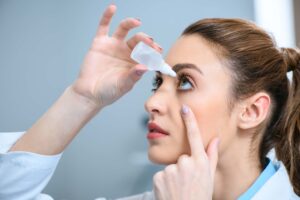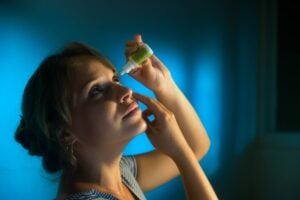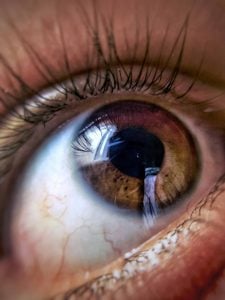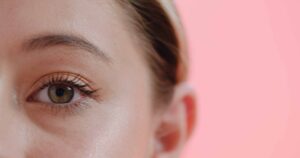Everything We Recommend
Best for Dry Eyes – Refresh Plus Lubricant Eye Drops
Best for Contact Lenses – Opti-Free Replenish Rewetting Drops
Best for Redness – LUMIFY Redness Reliever
Best for Itchiness & Allergies – Zaditor Antihistamine Eye Drops
Best for Eye Infections – Speak with your doctor
What are Eye Drops?
Eye drops are a safe and effective treatment for many eye conditions. They help provide relief from certain eye conditions and symptoms, including:
- Dry eyes
- Redness
- Itchy eyes
- Dry eyes due to contacts
- Eye soreness
- Eye swelling or discharge
It’s important to make sure you use the right type of eye drops. In this article, we’ll cover the different types of eye drops and our top recommendations for each type.
Note: This guide does not replace advice from your doctor. Certain medical eye drops are only available with a prescription. If you have any questions about your eye health, make an appointment with an eye doctor.
Our Top Recommendations for Eye Drops
Here are our top recommendations for eye drops:
Best Eye Drops for Dry Eyes: Refresh Plus Lubricant Eye Drops
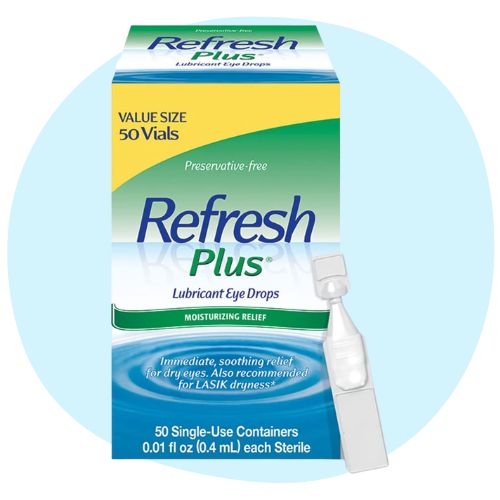
Refresh Plus Preservative-Free Lubricant Eye Drops are designed to alleviate dry and irritated eyes. They mimic the properties of natural tears to provide instant hydration and comfort.
The drops come in single-use vials and can be used safely with contact lenses as often as needed. You can even use these eye drops after LASIK surgery.
Pros
- Refresh’s eye drops effectively moisturize and lubricate dry eyes
- The eye drops offer good value for money
Cons
- Some customers find it difficult to open the vials when using the drops
- Others find it hard to squeeze out the eye drops from the vial
Best Rewetting Eye Drops for Contact Lenses: Opti-Free Replenish Rewetting Drops
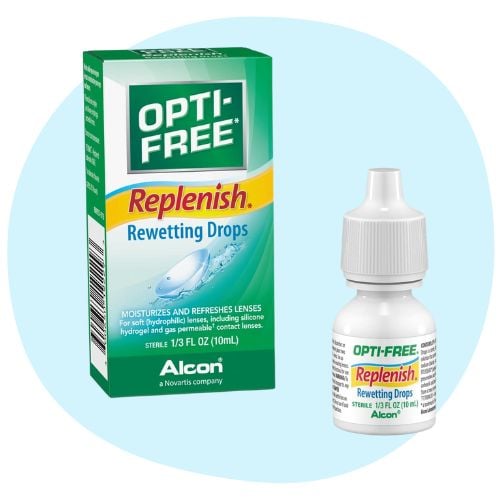
Opti-Free Replenish Rewetting Drops help ensure a constant moisture level for different types of contact lenses. They assist in preventing protein accumulation and removing substances that can cause discomfort or irritation.
Unlike other Opti-Free products, these drops are meant to be applied directly to the eye instead of only used for soaking the lens.
Pros
- Many customers find that these drops relieve dry eyes from contacts immediately
- These eye drops also work for people with sensitive eyes
Cons
- Some customers find these eye drops expensive for the price
- The eye drops can cause eye stinging in some people
Best Eye Drops for Redness: LUMIFY Redness Reliever
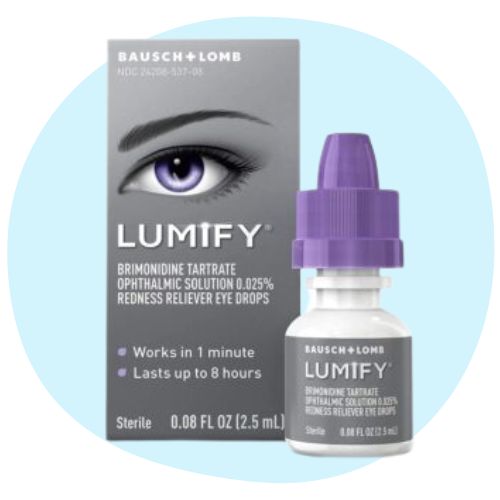
LUMIFY is an FDA-approved eye drop solution developed by physicians. It quickly diminishes redness and improves the appearance of the eyes by making them look brighter and more vibrant.
The clinical effectiveness of this product has been proven. It provides long-lasting relief and has a lower likelihood of negative effects due to its unique method of addressing redness selectively.
Pros
- Most customers achieve their desired benefits and results from LUMIFY
- The drops instantly whiten and brighten red eyes
Cons
- Some customers experience difficulty opening the bottle
- A few have complained about experiencing headaches when using the product
Best Antihistamine Eye Drops: Zaditor Antihistamine Eye Drops
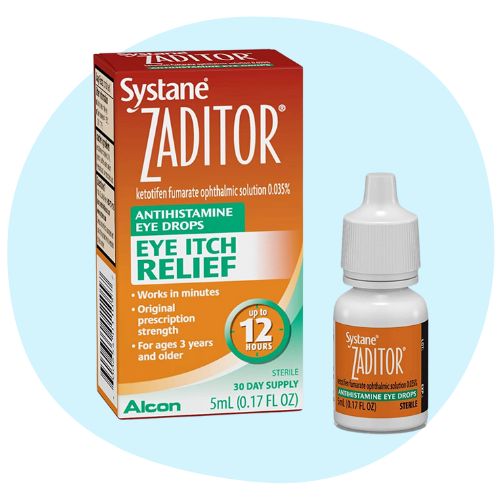
Systane Zaditor Antihistamine Eye Drops is a prescription-strength formula that relieves itchy eyes caused by allergens. It works fast and provides up to 12 hours of comfort.
Unlike oral medications, allergy drops directly address the root cause of the itch. This triple-action solution can be used by adults and children over 3.
Pros
- Many doctors recommend using these eye drops for itchy eyes due to allergic reactions
- The product offers quick relief, even if only using a small amount
Cons
- While the eye drops work, some customers find that they aren’t as effective as other products
- Other customers find the amount of product too little for the price
Why Trust Us
As a trusted website for eye health, Vision Center aims to provide honest and unbiased reviews about eye products.
We did the following to ensure the accuracy and reliability of this article:
- Spent several hours researching the different types of eye drops on the market, including their pros and cons
- Looked through customer reviews to get an accurate picture of their experience using the product
- Talked to various eye care professionals to know their thoughts and recommendations about different eye care products
- Reviewed the latest scholarly articles to have an updated understanding of the latest in eye care
Types of Eye Drops
There are many different kinds of eye drops. Each type is designed to treat a certain set of conditions.
Here are the most common types of eye drops:
1. Lubricating Eye Drops (Artificial Tears)
Lubricating eye drops, or artificial tears, are the most common. They treat dry eyes caused by:
- Digital eye strain (computer vision syndrome)
- Eye strain from tiredness and other physical factors
- Environmental factors like excess sunlight, wind, or dust
- Medical conditions or medications
- Aging
Lubricating eye drops add moisture to the eye’s surface so the tear film works more effectively, relieving dry eyes. This is why they’re also known as artificial tear drops.
If you have mild to moderate dry eyes, OTC eye drops may help you. Consult a physician if artificial tears don’t improve your symptoms.
There are two categories of lubricating eye drops:
Eye Drops With Preservatives
Drops with preservatives have added ingredients to fight the growth of bacteria once you open the bottle. As a result, they have a longer shelf life.
However, the preservatives may irritate your eyes, especially if you apply eye drops more than four times daily. Limit your use of eye drops with preservatives when using them.
Preservative-Free Eye Drops:
Preservative-free eye drops are recommended for people who apply eye drops four or more times a day.
They’re best for moderate to severe dry eyes. Those with sensitive eyes are also recommended to use preservative-free eye drops.
2. Rewetting Eye Drops
Rewetting drops are made specifically for contact lens wearers. They provide relief for dryness and discomfort from wearing contact lenses.
Not all lubricating eye drops are compatible with contact lenses. You may need to remove your contacts before applying them.
If your lenses are causing dry eye or discomfort, rewetting drops may help. If you believe your eye dryness is caused by something else, contact your eye doctor.
Read about the best eye drops for contact lenses.
3. Decongestant (Whitening) Eye Drops
Decongestant eye drops treat red eyes. They contain vasoconstrictors that shrink the blood vessels in your eye to reduce redness.
Decongestant eye drops can help improve the appearance of your eyes. However, they can mask the underlying causes of dry eyes.
Anti-redness drops can irritate your eyes if you use them too much. Additionally, your eyes can get dependent on them.
You should only use decongestant eye drops intermittently. They’re made to improve the appearance of your eyes, not treat any eye conditions.
4. Antihistamine (Allergy) Eye drops
Antihistamine eye drops treat itchy, watery, red eyes caused by allergic reactions. These can be caused by:
- Pollen (seasonal allergies)
- Pet dander
- Mold
- Other common allergens
When your body has an allergic reaction, it releases histamines. Histamines cause allergy symptoms such as runny nose, itchy eyes, sneezing, skin reactions, etc.
Allergy eye drops contain antihistamines, which stop the effects of histamines. Therefore, antihistamine eye drops are only effective at treating symptoms due to allergies.
Read more about antihistamine eye drops.
5. Antibiotic/Antibacterial Eye Drops
Antibiotic (antibacterial) eye drops treat bacterial eye infections. Common eye infections include:
- Conjunctivitis (pink eye)
- Contact lens infections
- Styes
However, these eye drops don’t cure viral or fungal infections. Lubricating eye drops can help relieve symptoms of infections.
Remember that antibiotic eye drops require a prescription. If you have an eye infection, it’s best to speak with an eye doctor before purchasing these products.
Other Types of Prescription Drops
Depending on your needs, your ophthalmologist or other eye care specialist might recommend:
- Antifungal eye drops. To treat fungal eye infections
- Pressure-lowering drops. For long-term glaucoma treatment
- Steroid eye drops. To treat severe eye irritation and inflammation
- Dilating drops. Used for dilated eye exams
Are Artificial Tears Safe?
Eye drops are generally safe when used as directed by your eye care provider. However, there’s always some risk when you put something in your eye. This includes eye drops and contact lenses.
Artificial tears can cause side effects, such as:
- Blurred vision
- Allergic reactions
- Swelling
- Dizziness
- Trouble breathing
Stop using the eye drops and call your doctor immediately if you experience any of these symptoms.
How to Find the Best Type of Eye Drops
Not all eye drops will be suitable for everyone. Here are some factors to consider:
Ingredients
Different drops will have different ingredients. Finding the right ingredients will help you properly address your symptoms.
Checking the ingredients can also help determine whether the contacts contain any ingredients that cause allergies.
Cost
The product’s cost should also be considered.
Some eye drops can be expensive, so it’s important to compare prices to find an affordable product. To check whether the cost is reasonable, compare it with other similar products. It’s usually a good idea to shop around for the best price.
You can also divide the cost by the number of uses to get an idea of the price per drop.
Contact-Specific Formula
If you wear contacts, ensure the packaging indicates the solution is safe to use while wearing contact lenses. When in doubt, ask your pharmacist or eye care specialist if you’re meant to use the formula when your contacts are in.
For example, only use preservative-free drops when wearing contact lenses. Preservatives can cause eye irritation and damage your lenses.
Once you’ve found a solution safe for contacts, ensure they’re made for the type of contact lenses you wear.
Physician Recommendation
If you’re unsure which eye drops to buy, consult your eye doctor. They can provide recommendations based on your condition and needs.
Your doctor may also prescribe certain eye drops to help address specific symptoms.
How to Put in Eye Drops
Follow these step-by-step instructions to put in eye drops:
1. Read the Instructions
Before handling your eye drops, make sure you know what you’re doing. If your eye drops are prescription, listen to your doctor. If your drops are over-the-counter, read the instructions entirely.
For example, how often you use your eye drops depends on the kind of eye drops you’re using. Prescription eye drops should be used as recommended by your doctor.
You may use preservative-free eye drops every day, but they shouldn’t serve as a long-term solution.
2. Wash Your Hands
Before touching your eyes or eye drops, wash your hands. Be especially careful around the tip of your dropper.
If you touch the dropper tip, it could pick up bacteria from your fingers. This could potentially contaminate the products.
Don’t share your eye drops with anyone else. Sharing your drops (or any other eye products) will increase the risk of cross-contamination. Always keep your eye products for personal use only.
3. Get Comfortable and Prepared
You can stand, sit, or lie down to put in the drops. Whatever makes you comfortable and helps you keep your eyes open. Shake the bottle vigorously before opening it.
4. Look Up and Squeeze the Bottle
Once you’re comfortable, the bottle is shaken and open, look up. Some people say that focusing on a specific point on the ceiling can help. Use one hand to pull your lower eyelid down. This forms a pocket to help “catch” the drop.
Using your other hand, position the dropper over your eye. Slowly squeeze the bottle until one drop falls onto your eye.
5. Close Your Eyes
Once the eye drop is in, close your eyes for two minutes. After two minutes, the drop is fully absorbed.
If you are supposed to put in more drops, you can then repeat the procedure. Keep your eye closed for two minutes between each drop.
Summary
- Eye drops are a safe and common treatment for many eye conditions like fungal infections or dry eye disease.
- There are several different types of eye drops, and it’s important to find the one that best fits your needs.
- Always consult your doctor to find the right eye drops for your needs and condition.
- To avoid any side effects, follow the instructions that come with your eye drops.
In this article


